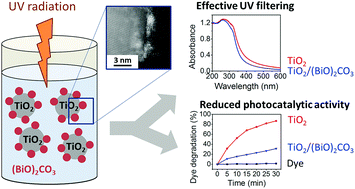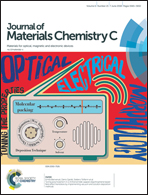TiO2/(BiO)2CO3 nanocomposites for ultraviolet filtration with reduced photocatalytic activity†
Abstract
TiO2 nanoparticles are typically used in sunscreens; however, they have been shown to exhibit cyto- and genotoxicity, which is related to the photocatalytic activity and the subsequent formation of reactive oxygen species when exposed to ultraviolet radiation. In this study, we synthesised nanocomposite materials consisting of TiO2 nanoparticles and homogeneously attached (BiO)2CO3 clusters with a size <10 nm onto their surfaces. The nanocomposites were prepared using a facile precipitation approach with different atomic ratios of Bi/Ti of 0.02, 0.04, and 0.08. The TiO2/(BiO)2CO3 nanocomposites exhibit an absorbance in the ultraviolet-visible range that is similar to that of TiO2 nanoparticles and photocatalytic activity that is reduced by up to 60% when exposed to ultraviolet and visible light. In addition, the nanocomposites show high biocompatibility in healthy HaCaT human skin cells and Madin–Darby canine kidney cells in vitro, and more importantly, they are capable of reducing the photo-generated toxicity of TiO2 in HaCaT cells upon irradiation with simulated sunlight. Such multifunctional nanocomposites could potentially be applied as alternative ultraviolet filter components in sunscreen formulations, reducing potential adverse effects associated with TiO2 nanoparticles.

- This article is part of the themed collection: 2018 Journal of Materials Chemistry C HOT Papers


 Please wait while we load your content...
Please wait while we load your content...
